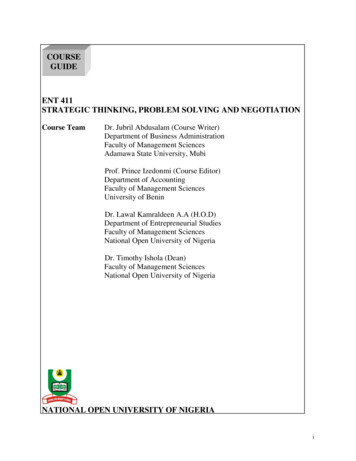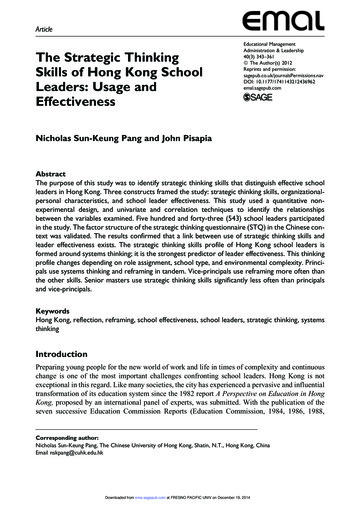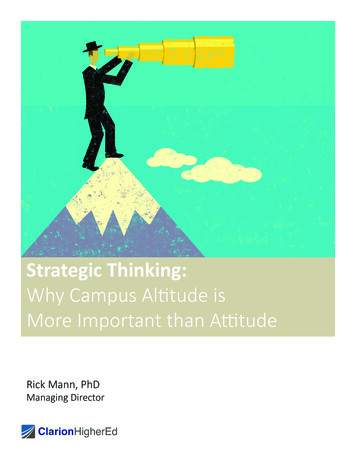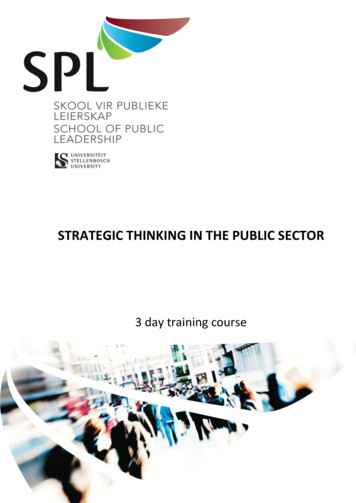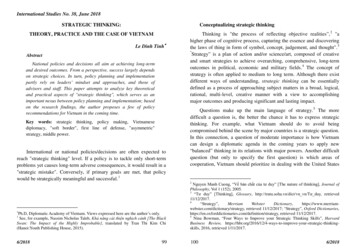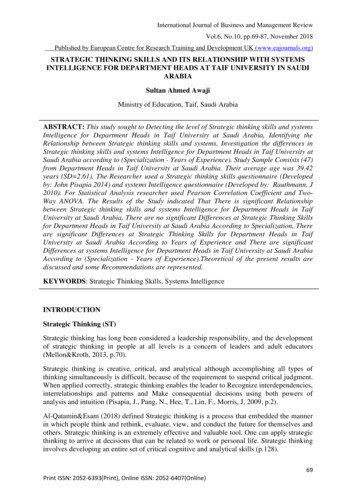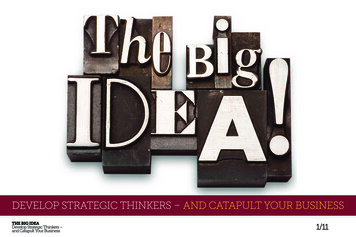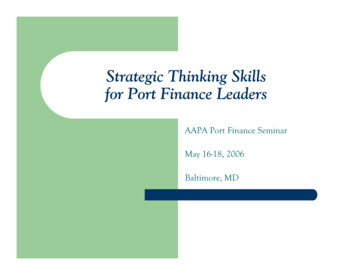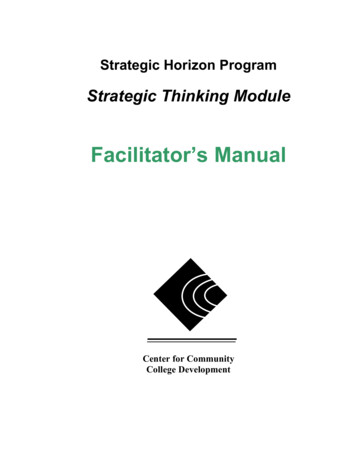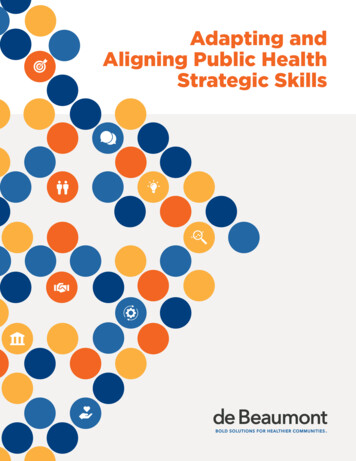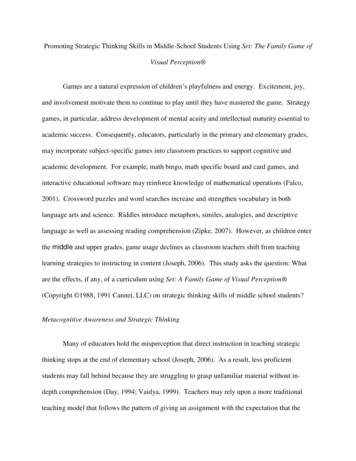
Transcription
Promoting Strategic Thinking Skills in Middle-School Students Using Set: The Family Game ofVisual Perception Games are a natural expression of children’s playfulness and energy. Excitement, joy,and involvement motivate them to continue to play until they have mastered the game. Strategygames, in particular, address development of mental acuity and intellectual maturity essential toacademic success. Consequently, educators, particularly in the primary and elementary grades,may incorporate subject-specific games into classroom practices to support cognitive andacademic development. For example, math bingo, math specific board and card games, andinteractive educational software may reinforce knowledge of mathematical operations (Falco,2001). Crossword puzzles and word searches increase and strengthen vocabulary in bothlanguage arts and science. Riddles introduce metaphors, similes, analogies, and descriptivelanguage as well as assessing reading comprehension (Zipke, 2007). However, as children enterthe middle and upper grades, game usage declines as classroom teachers shift from teachinglearning strategies to instructing in content (Joseph, 2006). This study asks the question: Whatare the effects, if any, of a curriculum using Set: A Family Game of Visual Perception (Copyright 1988, 1991 Cannei, LLC) on strategic thinking skills of middle school students?Metacognitive Awareness and Strategic ThinkingMany of educators hold the misperception that direct instruction in teaching strategicthinking stops at the end of elementary school (Joseph, 2006). As a result, less proficientstudents may fall behind because they are struggling to grasp unfamiliar material without indepth comprehension (Day, 1994; Vaidya, 1999). Teachers may rely upon a more traditionalteaching model that follows the pattern of giving an assignment with the expectation that the
student will produce the work. The teacher then evaluates the product and assigns a grade. Astudent may rely upon rote memorization and fact regurgitation rather than developing a deeperand more substantive understanding of the subject (Day, 1994). In short, the student becomes apassive participant in her education because she does not understand how or why she learns(Joseph, 2006). Deepening her awareness of her cognitive processes and developing appropriatelearning strategies may engage the student more fully and enhance her educational experience.The student builds metacognitive awareness, which according to Joseph, is “the ability to be selfreflective learners by thinking about their own thinking they are able to reflect upon theircognitive processes” (Joseph, 34). Strategic thinking, an integral part of metacognitiveawareness, allows learners to access prior knowledge, monitor comprehension, correctmisconceptions, synthesize information, draw inferences, and ask questions. As a result, theybegin to understand and own their cognitive processes. Strategy games, such as Set: The FamilyGame of Visual Perception may support the production of strategic thinking skills and possiblyincrease metacognitive awareness. Finally, skills acquired playing Set may transfer orgeneralize to academic endeavors in the classroom.Background of StudyAttributes of Set As an educational therapist, I have observed that incorporating Set into student sessionsappears to have had positive effects on the students’ metacognitive awareness and strategicthinking abilities. Additionally, students enjoy the challenge and playfulness of the game. Set consists of eighty-one cards with four variable features:
Symbols—One of the following: ovals, squiggles, or diamonds Colors—Symbols are either red, green, or purple Number—Each card has one, two, or three symbols Shading—Symbols are either solid color, striped, or outlined with one of threecolorsPlayers search for three cards that represent a set based on specific criteria. Sets may consist ofsimilarities, differences, or a combination of both. In order to be successful, players must beaware of how they form sets and engage in strategic thinking to find them.Purpose of the StudyLearning non-academic strategy games such as Set: The Family Game of VisualPerception may more fully teach and integrate strategic thinking into a student’s academiclife. This study proposes to explore the relationship, if any, between increased proficiency inSet , and enhancement of strategic thinking in middle school students. Models formetacognitive instruction used to teach strategic thinking share common characteristics: teacherdirected instruction and modeling of strategic thinking skills, student/teacher guided practice andapplication, and independent student activity. For the purposes of this instruction, I used theMetacognitive Training Framework (MTF) used by Kelley and Clausen-Grace (Kelley, 2008),which incorporates teacher instruction and self-talk, teacher directed practice, and independentstudent practice. I selected Set as it incorporates the following cognitive skills: temporalsequential ordering, spatial ordering, memory, concept formation, creativity, reasoning or logicalthinking, shifting mental representations, and critical thinking—abilities that are essentialacademic and life skills (Falco, 2001). Using the explicit methods of strategy games may more
fully integrate these learning processes and provide a cognitive framework that transfers to othersubjects (de Bruin, 2007; Engle, 2006; Kramakski, Mevarach, & Lieberman, 2001; Rogers,1994). Additionally, incorporating Set into the classroom as a learning activity may provide anon-traditional, multidimensional approach to cognitive tasks, including memory, organization,strategy development, and abstract thinking skills. Just as simple word games, rhymes, andpoems lay the foundation for learning for young children (Zipke, 2007), Set might change theway in which older children achieve metacognitive awareness and strategic thinking skills.Effective Learning SkillsIn order to learn effectively and efficiently, individuals need cognitive skills anchored inmetacognitive awareness and strategic thinking (Day, 1994; Joseph, 2006). In learning to playSet proficiently, students engage in an analysis of how they think about set formation. Theyexplain strategies that they use and modify them to increase success at the game. This researcherhas discovered that engaging students in a discussion of how they perceive the sets enhancestheir enjoyment and success with the game. In order to do so, they need to think about how theythink or, in other words, increase metacognitive awareness. As an educator, I have observed thatas students move towards mastery, children who lack academic self-confidence begin to takepride in their abilities to excel at the game and appear to become more proficient strategicthinkers. This researcher’s experiences suggest that Set teaches and reinforces: Abstract or meta reasoning through strategy development and card sorting Metacognitive awareness through student evaluation of strategies Development and understanding of strategic thinking skills
Additionally, as players become more proficient, I have observed that students begin to processvisual cues more rapidly in order to become competitive players. They may also cultivate theability to swiftly interpret, remember, and create new information—required academic skills formature and independent learners. Game players also order objects into patterns and learn torecognize card sets simultaneously, attributes of mathematics, science, and readingcomprehension (Kramakski, Mevarach, & Lieberman, 2001). Finally, they learn toindependently organize and create their own sets, by applying specific rules. Due to theemphasis on metacognitive awareness and strategic thinking skills, it is hoped that these skillswill be applied beyond Set and into the classroom.Definition of TermsMetacognitive AwarenessMetacognitive awareness, for the purposes of this study, is defined as the ability to be a selfreflective and self-regulated learner who considers and comprehends her cognitive processes(Day, 1994). She is able to understand and use self-knowledge about cognitive strengths andweaknesses to develop additional skills and move towards intellectual maturity. She builds theability to think about and comprehend how she approaches learning as well as the ability to plan,monitor, and evaluate her learning. These skills aid students in reading comprehension, writing,memory, problem solving, and related areas of education (Joseph, 2006).Strategic ThinkingStrategic thinking, for the purposes of this study, is defined as a cognitive process thatallows astudent to access prior information, monitor comprehension, correct misunderstandings,
synthesize and extrapolate information, and ask relevant clarifying questions. Strategic thinkingmay be taught by training students in metacognitive awareness (Day, 1994).Literature ReviewMetacognitive Awareness, Strategic Thinking, and Knowledge AcquisitionFor the past thirty years, the role of metacognitive awareness and strategic thinking in theclassroom has been one of the major focuses of educational research (Beyer, 2008; Wong,1993). According to Beyer (2008), cognition, a multifaceted and complex mental phenomenon,requires the mastery and integration of four basic thinking skills: comparing, classifying,sequencing, and predicting. Metacognitive awareness requires that students recognize andunderstand their cognitive processes as well as how they apply those skills. Beyer asserts thatstudents who do not acquire these skills seldom become thoughtful and independent learners. Hecontinues that skill subsets such as decision-making, problem solving, drawing conclusions,analyzing, and identifying cause and effect develop critical thinking skills. He states further thatdirect instruction in metacognitive awareness and strategic thinking increases academicproficiency. Additionally, he concludes that this instruction must include further explicitstrategies for transferring the newly learned thinking skills to other domain-specific contexts(Beyer, 2008). The cognitive researchers and educators cited below have become involved indeveloping and introducing metacognitive curricula with the goal of integrating strategicthinking skills into classrooms.[1] The purpose of this literature review is to examine several ofthese approachesMetacognitive Awareness Defined
In order to create successful learners, educators attempt to arm their students with skillsnecessary for critical evaluation, attainment of new knowledge, and a dedication to life-longlearning. Metacognitive awareness, the ability to plan, monitor, and evaluate one’s learning,aids students in reading comprehension, writing, memory, problem-solving, and related areas ofeducation (Beyer, 2008; Day, 1994; Joseph, 2006). Students become aware of how their abilityto comprehend tasks and make judgments about possible outcomes through building strategicthinking skills affects their ability to more fully understand and internalize knowledge. Joseph(2006) states that, “studies of adolescent learning behavior describe that metacognitive behaviorcan be taught, resulting in practical skills to use throughout their lives” (Joseph, p. 34). Josephmaintains that the failure to establish and maintain an effective focus may lead to frustration,confusion, and lack of academic self-confidence. On the other hand, metacognitive awarenessand strategic thinking assist in learning how to access academic strengths and recognizeweaknesses (Day, 1994; Vaidya, 1999). Combined, the students attain intellectual maturity.Joseph continues that metacogtnitively aware students learn to access prior knowledge, monitorcomprehension, correct misunderstandings, synthesize information, draw inferences, askquestions, and internalize effective strategies for approaching learning (Joseph, 2006).Metacognition and Cognition DefinedIn order to grasp the relevance of teaching metacognitive awareness, both cognition andmetacognition need to be differiated and defined. Sungar (2007) states that metacognition differsfrom cognition in that, “cognitive strategies are task-related strategies such as note-taking,summarizing, and outlining, while metacognitive strategies emphasize planning and monitoringone’s learning and being aware of which strategies are suitable for use across academic tasks”
(Sungur p. 316). Vaidya (1999) adds that cognitive learning tends to be specific to the learningtask. As a result, some cognitive strategies may apply only to learning that particular task(Vaidya, 1999). On the other hand, metacognition helps a student to recognize her cognition andcontrol it. She develops the ability to plan, sequence, and monitor her cognition, therebyenhancing the academic outcome (Beyer, 2008; Day, 1994; Pressley, 1990; Protheroe, 2008). Inshort, the student is learning about effective and efficent learning. Unlike cognitive strategies,metacognitive strategies may be modified and transferred to other subjects or tasks (Day, 1994).While cognitive strategies represent concrete actions required for learning, metacognition delvesinto the more abstract and conscious control of material. Sungur (2007) asserts thatmetacognitive activities involve, “conscious experiences, which can be either cognitive oraffective, pertinent to ongoing cognitive processes likely to occur in situations that provideopportunities for thoughts and feEvanng about one’s own thinking to arise” (Sungur, p. 316).Research has shown the introducing a metacognitive model into the classroom supports thedevelopment of metacognitive awareness and strategic thinking skills (Joseph, 2006; Kelley,2008; McMahon, 2008; Vaidya, 1999). In order for students to build metacognitive awareness,teachers may construct an educational experience using specific metacognitive frameworks fromwhich creative, thoughtful, engaged and strategic learners emerge.Strategic ThinkingAn intergral component of metacognitive awareness is strategic thinking—a system of awell-thought out learning approachs that permit learners to effectively move from one point toanother. Strategic thinking consists of learning behaviors that direct and influence how thestudent processes information (Wong, 1993). Proetheroe and Clark (2008) further define
learning strategies as ways in which an individual approachs a task and how that person mightthink and act when planning, executing, and evaluating tasks (Protheroe, 2008). Vaidya (1999)notes that, “when these strategies are integrated into content area learning, the learningoutcomes are successful” (Vaidya, p. 187). She also bEvaneves that an individual’sinterpretation of these strategies influence future learning behavior.According to Day and Elksmin’s research (1994), low achieving students "oftenexperience continued frustration and failure in an academic setting" (Day, 264). They found thatthese students frequently do not have a comprehensive system for planning, organizing,rehearsing recalling information, and monitoring their performance. In short, they lack thinkingstrategies that might reduce frustration and increase success. They may become passive anddependent learners, incapable of learning independently (Day, 1994; Joseph, 2006; Vaidya,1999). Successful strategy instruction that focuses on how to learn effectively guides studentstowards metacognitive awareness. They also learn to modify acquired strategic thinking skills tomeet the needs of any classroom (Sungur, 2007). It is essential that students grasp the conceptthat strategies are useful in approaching, completing, or modifying task performance. They mustcomprehend the rationale behind a strategy's use and become intrinsically committed to usinglearning strategies (Beyer, 2008; Pressley, 1990).Metacognitive ExperiencesDay and Elksmin (1994) delineate several steps required for effective strategic learning.First, the students actively analyze their cognitive strengths and weaknesses; they are encouragedto set realistic goals that enhance motivation, focus attention, and provide incentives. Next, theinstructor models strategy development through self-talk as she explains her own thought
process. The teacher invites the students to participate in deciding what strategies the instructorintends to try. Both students and teacher provide examples of strategies and discuss variousways in which they may be used at school, in their homes, and within the community. Once thestudents have determined which strategies they might use, they create memory prompts such asbulletin boards or charts and mnemonic devices. The teacher continues to monitor studentefforts. Finally, they begin to explore and experiment with specific strategies based on thecontent and context, discarding those that are ineffective and retaining the ones that enhancetheir comprehension. By engaging in a metacognitive exercise, or thinking about thinking, thestudents become active participants in their educations. Kelley and Clausen-Grace (2008)concur in this assessment of appropriate methodology.Metacognitive Framework (MTF)The Metacognitive Teaching Framework (MTF) employed by Kelley and Clausen-Grace(2008) in their 2007 action research study of metacognitive transfer mirrors several aspects of theDay and Elksmin methodology. Kelley and Clausen-Grace examine the effects of teachingmiddle school students to be strategic thinkers in overall reading comprehension, particularlynon-fiction. Kelley and Clausen-Grace note that, “most of the texts used were related to thescience and social studies concepts being taught and included relevant textbooks, trade books,and student periodicals, such as Weekly Reader” (Kelley, p. 24). Kelley introduced the MTFcurriculum to Clausen-Grace’s middle school language arts classroom. [2] Kelley and ClausenGrace use the Developmental Reading Assessment (DRA) designed for grades 4-8 for both preand post-evaluation. Kelley states that, “this assessment tool places students at eitherintervention, instructional, independent, or advanced levels in the areas of engagement, fluency,and comprehension” (Kelley, p. 23). The assessment revealed that all students in the class would
benefit from direct instruction in connecting, predicting, questioning, visualizing, andsummarizing. As with Day’s structure (1994), the teacher initially demonstrates, defines, andexplains the introduced strategies. She may analyze what makes the task challenging andsuggest possible strategies for attaining a particular outcome or goal. The students then begin toassist in strategy development through discussion and practice. The teacher may ask the studentsquestions about how they arrived at a particular conclusion, offering assistance, and encouragingthe students to engage in strategic thinking. Finally, as the students gain competency inassessing strategies, they perform tasks independently. They consider their thought processesand apply them to attaining their academic goals (Joseph, 2006; Kelley, 2008). Ultimately,strategic thinking will become intrinsic and transferable to other tasks (Beyer, 2008, Day, 1994;Kelley, 2008; Protheroe, 2008). [3]Kelley and Clausen-Grace (2008) expressed concern that students may not be transferringthe strategic thinking to other areas of independent reading. Therefore, specific discussions ofstrategy use, observations, and evidence and use of tally sheets measured acquisition andintegration of strategies. In addition, the researchers designed self-assessment goal sheets foreach strategy, mirroring the tally sheets used in their direct instruction. Kelley and ClausenGrace concluded that introducing the MTF to their students enhanced their abilities to delve intoany text at a deeper level. They also assert that metacognitive strategies, once they becameintrinsic, will transfer to other academic tasks as the MTF promotes inquiry, provides a routinefor strategic learning, and builds a metacognitive vocabulary that can be applied to all academicendeavors (Kelley, 2008). Nancy Protheroe, et al’s (2008) research supports the Kelleyhypotheses and she notes that strategic thinking skills acquired through metacognitiveinstruction may transfer to other academic and non-academic tasks (Protheroe, 2008). In short,
educators can create a community of thoughtful strategic thinkers (Kelley, 2008). Furtherresearch by Kramakski, Mevarach, & Lieberman (2001) supports the importance of buildingcross-curricular strategies.Active physical participation in learning may have further benefits in enhancing strategicthinking. Rogers and Aston’s research (1994) explores four different learning strategies basedon Craik’s theory of memory and children’s learning. Craik’s theory contains four majorcomponents: remembering or learning, close attention, elaborate encoding consisting of depthand spread or embedding, and fully descriptive encoding (Rogers, 1994). Rogers and Aston’sstudy relies upon a concrete activity that involves physical interaction with a learningenvironment. Two hundred fifty-ten and eleven year olds participated in the study. Fourheterogeneous groups were assigned to one of four instructional interventions: formal teachingbased on a guided tour with no active student participation, guided discovery using teachergenerated worksheets with specific questions on salient features, free discovery with littleinstruction or direction, and finally, special learning games that focused the participants attentionon salient information. The results indicated that formal and guided discovery worked forconcrete information and recording of facts, but did not require independent thinking. Theparticipants often missed salient points and failed to recall them after a two-week interval. Freediscovery, on the other hand, supported analytical thinking and independent extrapolation ofinformation but failed in helping participants to formulate learning strategies for informationretention. Finally, those students involved in special learning games retained information andrecalled relevant details more readily. The researchers concluded that unstructured learning hadlittle benefit while a combination of formal instruction, guided inquiry, and learning gamesenjoyed the most positive effects. Rogers and Aston also noted that the learning games required
more strategic thinking than the other three methods and had the highest rate of retention(Rogers, 1994).Transfer and Generalization EffectsKramakski, Mevarach, & Lieberman (2001) studied the effects of two levels ofmetacognitive training on mathematical reasoning. Participants from six-seventh gradeclassrooms were assigned to one of three groups—multilevel, unilevel, or control. Participantsin the multilevel metacognitive training group (MMT) received metacognitive instruction in bothmath and English classes. Those in the unilevel training group (UMT) received metacognitiveinstruction in just mathematics. The control group had no metacognitive training. Kramanski,et al (2001) hypothesize that providing metacognitive training in both math and English (MMT)would lead to significant gains in achievement. On the other hand, those who participated inUMT classes or had no training would have lower levels of achievement. In fact, the results oftheir study indicated that the MMT group not only outperformed the UMT and control groups,but were able to transfer their strategic thinking skills to foreign language acquisition, solvingcomplex tasks, or solving more conventional problems. Additionally, the researchers discoveredno significant difference between the UMT and control groups the ability to transfer strategiesfrom one domain to another . Consequently, while some UMT participants showedimprovement in mathematics, similar gains in other academic subjects did not occur. However,they suggest that future researchers might develop more appropriate domain-specificmetacognitive training frameworks in order to support cross-curricular transfer.Explicit training in metacognitive awareness and strategic thinking encourages studentsto become independent and self-aware learners (Beyer, 2008; Day, 1994; Joseph, 2006;Protheroe, 2008). The research cited above suggests that strategic thinking skills may be
transfered or generalized from on domain to another. [4] Several of the cited researcherstheorize that because direct instruction in strategic thinking focuses on understanding thecognitive process , transfer between domain specific tasks may occur (Day, 1994; de Bruin,2007; Kramakski, Mevarach, & Lieberman, 2001). DeBruin (2007) requires that participantsanalyze strategic moves in a chess endgame. Participants’ strategic training focuses on selfreflection and self-regulation as well as prediction and judgement. De Bruin (2007) believesthat these insights into cognitive processing might transfer to educational settings and improveacademic outcomes. Day agrees that, “strategy instruction in specific academic areas has notonly increased student performance, but has also fostered greater involvement in learning,yielded higher frequency of strategy use, and created greater awareness of strategic approaches”(Day, p. 267). He further asserts that strategic instruction aids students in developingtransferrable metacognitive techniques that may be modified and adapted to different learningsituations (Day, 1994). Sungar (2007) concurs that students trained in metacognition andstrategic thinking have learned to “emphasize planning and monitoring one’s learning and beingaware of which strategies are suitable for use across academic tasks” (Sungur, p. 315).Therefore, the successful strategic thinker has internalized the value of learning in addition tofactual knowledge. She may also learns to control the outcome of endeavors throughmetacognition and self-efficacy—the capacity to learn proficiently (Sungur, 2007).Kramarski, et.al.’s study (2001) of multilevel metacognitive training (MMT) submitsthat cross-domain training strenghtens strategic thinking skill. Their research hypothesizes thatstudents receiving MMT would successfully generalize strategic thinking skills from one domainto another. They found that students not only internalized the methodology, but also effectivelymodified and adapted techniques between mathematics and English classes. The study
partcipants learned to analyze problems, activate prior knowledge, and select appropriatestrategies (Kramakski, Mevarach, & Lieberman, 2001). Engle’s (2006) study of fifth gradersalso directly addressed skill transfer and generalization. Her findings support the Kramarski,et.al’s(2001) conclusion that skills may be transferrable from one domain to another. However,Engle’s procedure contrasts with cognitive models that rely upon what students do or say.Instead, Engle believes that the educational setting, or stituational context, determines the levelof transfer. She found that “transfer is more likely to occur when learning contexts are framedas part of a larger ongoing intellectural conversation in which students are actively involved”(Engle, p. 451). She continues that, “generative learning—learning that results in the flexibleuse of what has been learned in a wide range of relevant future situations” has a greater impacton generalization (Engle, p. 451). She believes that intercontextuality is essential andhypothesizes that the learning environment must be designed to enhance transfer to a largerintellectual venue.SummaryMetacognitive awareness provides the framework for building strategic thinking skills.Current research indicates that training students in strategic thinking has wider application in theclassroom and the community. Through direct and explicit instruction in these skills, studentslay the foundation for thoughtful, critical, and independent learning. They develop the ability tomake decisions, solve problems, draw conclusions, analyze information, and identify cause andeffect. In short, students may increase their academic proficiency and become self-regulated,autonomous learners who have the skills to direct their own learning. As noted in the citedresearch, acquiring these skills goes beyond single-subject competency. Students who havedeveloped metacognitive awareness and efficient learning strategies may be able to transfer or
generalize from one specific domain to another. However, further research needs to be done infacilitating the integration of strategic instruction into classrooms. As Beyer (2008) notes, “thereare gaps and omissions even in research that exists. Educational research is an ongoingenterprise changing with the educational interests of the times” (Beyer, p. 231).MethodologyPromoting Strategic Thinking Skills in Middle-School Students Using Set: The FamilyGame of Visual Perception Research QuestionThe study addresses the following research question:What are the effects, if any, of a curriculum using Set: A Family Game of Visual Perception on strategic thinking skills in middle school students?Instructional MaterialsThe instruction relied upon Set: The Family Game of Visual Perception , which provides aconcrete and hands-on experience. The game focused on strategy development, visospatialcompetency, working memory, and organizational skills. The card game consists of eighty-onecards with four variable features: Symbols—One of the following: ovals, squiggles, or diamonds Colors—Symbols are either red, green, or purple
Number—Each card has one, two, or three symbols Shading—Symbols are either solid color, striped, or outlined with one of threecolorsThe object of the game is to select three cards from a grid that constitute as set. The grid beginswith twelve cards. Three additional cards are added when a set is discovered and removed, orwhen there is no set in the grid. Sets rely on a combinatio
Set , and enhancement of strategic thinking in middle school students. Models for metacognitive instruction used to teach strategic thinking share common characteristics: teacher directed instruction and modeling of strategic thinking skills, student/teacher guided practice and application, and independent student activity.
